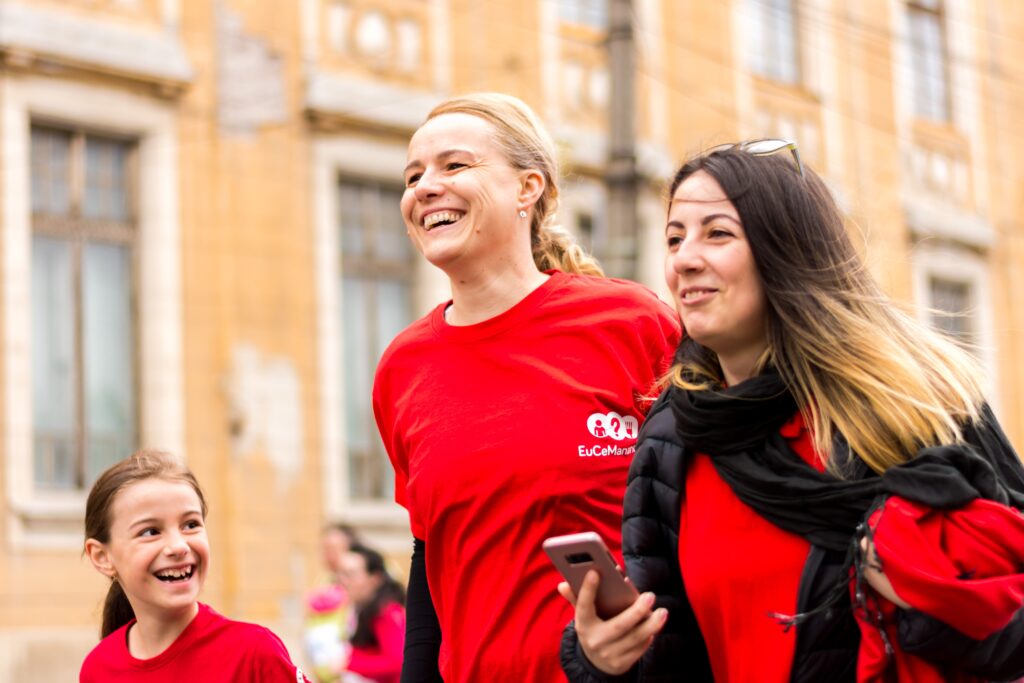Peer-to-peer fundraising has become a core pillar in the nonprofit fundraising toolkit. Among all the advantages, these events require relatively low investment compared to other campaigns from a time and cost standpoint. If you want to strengthen the relationship with your existing participants and reach new individuals, peer-to-peer fundraising is for you.
The coordination and organization required to run these fundraisers may serve as a barrier to entry for some nonprofit organizations. Kambeo’s technology is lifting that barrier, making it easier than ever to run a peer-to-peer fundraising event.
Kambeo simplifies the administration and organization of peer-to-peer fundraising. With our platform, you can leverage your existing donor base to raise both funds and awareness for your cause.
This article looks at the benefits of peer-to-peer fundraisers, best practices, and tips to ensure your event is successful. We also dive into how Kambeo helped one of Canada’s most prominent nonprofit organizations hold its first virtual peer-to-peer fundraiser.
What is Peer-to-Peer Fundraising?
Peer-to-peer fundraising is where participants utilize their own networks of friends and family to receive donations. Individuals will set up their customized page, tell the story of the related cause, and collect donations from their network.
Peer-to-peer fundraising usually has an event component tied to it as well. These events typically involve physical activities such as running, biking, or walking. Although they aren’t competitive, some group pages may include leaderboards that show the top contributing individuals and teams.
10% of donors create their own peer-to-peer fundraising campaigns on behalf of nonprofits.
39% of nonprofits use a peer-to-peer fundraising platform, an increase of 31% from the previous year.
This type of fundraising is also what we might call “DIY” fundraisers. Where participants will raise funds for your organization at the time and place of their choosing. The most common type of DIY fundraiser involves participants asking for donations through their social media networks to commemorate an event. Some examples include birthdays, anniversaries and graduations.
The Benefits of Peer-to-Peer Fundraising
1. Strengthen existing relationships
Your fundraiser has the potential to deepen the relationship with your current donors. Peer-to-peer fundraising engages donors while empowering them to become a true part of your mission.
Peer-to-peer events give donors a rare opportunity to support your organization with something more valuable than money: their time. While direct donations are critical to most nonprofits, donating money to a cause doesn’t always forge a deep, emotional connection.
Your donors have already formed an emotional bond, or they wouldn’t give to you in the first place. Peer-to-peer events enrich and deepen this bond by making donors a vital part of the fundraising efforts. They aren’t just investing their own money into the cause; they’re taking the time and putting in the effort to actively fundraise on your behalf. This results in a long-lasting relationship built on respect and compassion.
The relationship isn’t just solely between two parties: the nonprofit and the donor. The nature of these fundraisers often requires coordination between the donors and members of your staff. This direct interaction will give your staff greater insight into how this group thinks and what motivates them.
2. Increases new donor acquisition
Acquiring more donors will increase the success of any fundraising initiative. Peer-to-peer fundraising is backed by this philosophy— those in your network will spread the word amongst their connections.
Donors willing to participate in peer-to-peer fundraisers are your most enthusiastic and eager supporters. By activating their personal network, they introduce entirely new audiences to your brand, goals, and mission. In this case, donors are more likely to give money to a friend’s fundraising event than to other campaigns.
It can be quite challenging to ask for donations without the help of your willing contributors. That’s why you must provide your participants with the tools they need to go out and secure those donations. This can include in-person or online training, information packages and supporting documents, and clear communication channels.
3. Builds trust among new donors
Many people treat fundraising requests with a certain amount of suspicion. This is somewhat understandable in cases where they may be unaware of the issues you’re trying to remedy. Until they know your organization and fully understand the cause you are fighting for, this suspicion will likely persist.
Peer-to-peer fundraisers accelerate this process to lightspeed. Your participants serve as “brand ambassadors,” vetting for your organization’s cause and purpose through all of the outreach they conduct. This greatly increases initial trust among the new donors they secure.
4. Generates awareness around your cause
Peer-to-peer fundraisers are a fantastic way to spread awareness. When participants ask for donations from their friends and family, this will inadvertently build momentum around your organization’s mission.
Potential donors will always hear the pitch out, even if that doesn’t always result in a donation. If someone in their close circle thinks your cause is important enough to support, they could donate in the future.
5. Amplifies social media presence
When done efficiently, social media can help boost any nonprofit campaign. For peer-to-peer campaigns, however, leveraging social media is essential to success. Make sure your social media pages communicate your message clearly and give potential donors an easy way to connect with your organization.
You must also give your participants simple and easy options to promote your event. Ideally, participants should be able to share their personal or team fundraising page directly to platforms like Facebook, Twitter, and Instagram. This will help them raise a sufficient amount of funds and make sure your event continually stays in front of their personal network.
6. Boosts brand recognition
Having a well-defined brand, also known as brand recognition, helps attract donors who are aligned with your cause. Brand recognition relies on the visual elements associated with your organization— like your logo, color palette, and tagline. New donors often become interested in your cause the first time they recognize any of these elements.
Your peer-to-peer event has the potential to boost your brand recognition, as participants share their personal fundraising pages that usually include one or more of your branded visual elements. Ensure that all participants are using the right branding for clarity and consistency across the board.
7. Increases return without increasing investment
Your fundraiser must bring in more than it costs to run. Increasing awareness and strengthening donor relationships are great goals, but the event must also generate donations to be successful.
Today, you can run an entire peer-to-peer event online, significantly reducing the costs and legwork traditionally associated with the start-up and promotion. Using Kambeo, you can even cut costs further with our free software. The low cost of a peer-to-peer fundraiser makes it a great method to raise funds, build your donor base, and increase awareness of your cause.

How to Run a Successful Peer-to-Peer Fundraising Event
Set a clearly defined goal
Setting a goal gives your team and the event participants something to strive towards. It also gives you insight into how and where you can improve for the next event.
Consider breaking your overall goal into milestones to help boost overall morale and track performance seamlessly. For example, set goals for your peer-to-peer fundraiser in monetary increments. When you reach these milestones, make it known to each donor so they can be proud of their hard work.
Identify and reach out to previously engaged participants
Usually, your initial supporters will come from your existing donor base. These primary participants are likely the donors who engage with your organization the most. (To note, this isn’t necessarily the same as your top donors in monetary terms).
Alongside your initial supporters, look for participants who routinely engage with your social posts or have attended previous events. These super-engaged participants are already halfway to being unofficial brand ambassadors. Inviting them to take part in your peer-to-peer fundraiser might just be the boost they need.
For instance, an email campaign is an inexpensive and effective way to open the lines of communication. Make sure to let them know that you would appreciate their involvement both as promoters and as active participants. Some people won’t be able to participate in live events such as walks and runs. However, they can still be an extremely valuable asset when promoting the event to their network.
Build an online community
The purpose of an online community is to highlight the contributions made by individuals and teams. This will build their reputations within their communities and may even encourage new individuals to become involved.
Online community building can be achieved through social media platforms, a designated landing page, and Kambeo’s custom event pages. Your online community should function as a space where all participants can share their stories and tips for success. You may have to do some moderation to ensure that your online community is welcoming to all participants.
Now that you know all about peer-to-peer fundraising events, let’s look at a real-world example.
The Power of Peer-to-Peer Fundraising: MADD Canada’s Strides for Change
MADD Canada is one of the country’s best-known nonprofits, with local chapters in every province. Early in 2020, the pandemic closed off many of MADD Canada’s traditional avenues for fundraising.
The organization’s staff and volunteers began to look for ways to continue their mission; however, many of the options they found were expensive, difficult to implement, or both. Fortunately, the organization also found Kambeo.
After a series of demonstrations, MADD Canada decided to run their annual peer-to-peer fundraiser event: Strides for Change. For the first time, Kambeo enabled MADD Canada to host the fundraiser virtually. They hosted every aspect of their event online, including recruiting participants, accepting pledges, collecting donations, and holding an auction.
In fact, MADD Canada was so impressed with Kambeo’s functionality that they committed for three years to use it for all national-level fundraising activities!
For more on how MADD Canada used Kambeo to boost the 2020 Strides for Change event, please click here.
The Advantages of Using Kambeo for Your Peer-to-Peer Campaign
More than any other type of fundraising, peer-to-peer events require a lot of coordination and communication between multiple parties. In other words, nonprofits need a platform that is simple to use.
Kambeo’s simple interface will have you ready to run your first peer-to-peer fundraiser in minutes.
Moreover, you can create any fundraising event on Kambeo using pre-built templates or by configuring the event manually. Using the template ensures that your event’s page will include everything necessary to run a successful fundraiser, such as:
- A dedicated page for your peer-to-peer event, serving as a central hub for communications, volunteer management, and donor recruitment
- The ability for participants to create their own individual or team pages
- A team search function, allowing participants to join an existing team
- Fundraising and pledge management
- Secure payment processing through Stripe
- Leaderboards to show the progress of individuals and teams
- Built-in social sharing buttons that make it easy for your participants to promote the event
Today, Kambeo’s tools for peer-to-peer fundraising have helped nearly 250 organizations run successful events. And, they can work for you, too.



